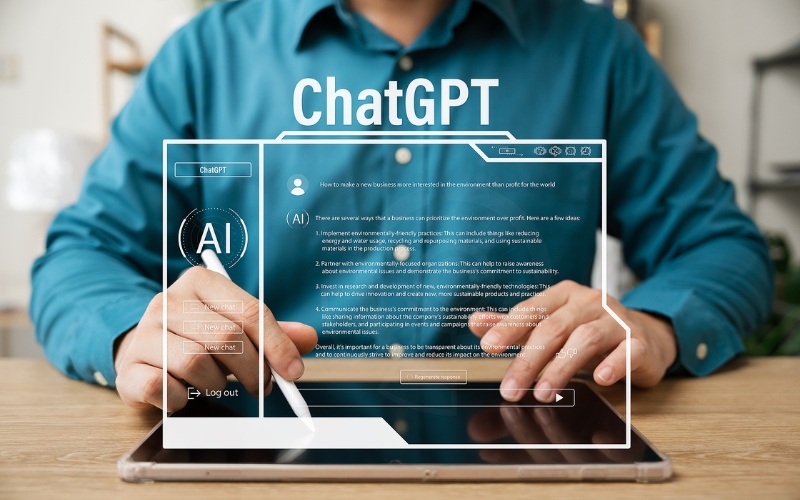Author: Maria Goyer is the Chief Innovation Officer at Innovative Employee Solutions
Key Takeaways:
- AI is transforming contingent workforce management by automating administrative tasks, optimizing payroll, and ensuring compliance.
- AI-driven talent acquisition enhances candidate matching, supports résumé optimization, and enables bias-free hiring practices.
- AI improves contingent workforce experiences through personalized job matching, seamless onboarding, and upskilling opportunities.
- Businesses using AI-powered workforce management platforms gain real-time insights, optimize labor allocation, and streamline operations.
- Overcoming AI challenges — such as bias, data security, and workforce resistance — requires ethical guidelines, transparency, and employee training.
The world of work is transforming rapidly, and businesses need to keep up. Artificial intelligence (AI) is no longer a tech buzzword — it’s a powerful tool reshaping how companies manage their workforce. For organizations relying on contingent talent, this shift is especially significant. As economic uncertainties and skills shortages persist, contingent workers have become essential for scaling operations and staying competitive.
By combining AI with Employer of Record (EOR) services, businesses can simplify workforce management, ensure compliance, and access talent across the globe. If your organization is exploring EOR solutions, understanding how AI enhances contingent workforce strategies is key to achieving long-term success.
AI in Contingent Workforce Management
Managing a contingent workforce involves navigating compliance, onboarding, payroll, and performance tracking — all of which can benefit from AI-driven efficiency. Here’s how AI is transforming contingent workforce programs:
Automating administrative tasks.
Repetitive tasks, like payroll processing and timesheet approvals, often drain resources. AI-powered tools can handle these with minimal human intervention, allowing you to focus on strategic goals. AI payroll processing also facilitates compliance while streamlining tax filings across jurisdictions.
Enhancing candidate matching.
Finding contingent talent quickly and effectively is critical. Using AI for candidate matching can help analyze vast datasets, matching candidates based on specific skills and project needs rather than generic job titles. This lets you build highly specialized teams, ensuring the right talent is in place to meet project demands.
Dynamic rate optimization.
AI can assess market trends and pay rate data in real time, ensuring competitive compensation for contingent workers while managing costs. This capability helps your company avoid overpaying while making sure workers are compensated fairly based on skills, location, and demand.
Predictive talent analytics.
AI-driven analytics offer insights into talent gaps, project timelines, and workforce costs. By forecasting future labor needs, you can proactively engage contingent workers or redeploy existing talent to high-priority projects. This agility helps maintain operational continuity.
AI in Talent Acquisition for Contingent Workers
Attracting and retaining contingent talent is increasingly competitive. Understanding how to use AI in talent acquisition is critical for staying ahead and finding the right people for your organization. AI plays a transformative role in talent acquisition by:
Streamlining sourcing and screening.
AI tools automate sourcing from global talent pools, identifying candidates with the right skills and experience for specific roles. By integrating these tools into your contingent workforce program, you save time and ensure quality hires.
Supporting résumé optimization.
AI tools assist contingent workers in tailoring their résumés to better align with job descriptions, improving their chances of being selected. This creates a mutually beneficial scenario, as your business can quickly find candidates who match your exact needs.
Prescreening with voice AI.
Voice AI technologies can conduct initial interviews, evaluate candidate responses, and log results for recruiters. This 24/7 functionality enhances the speed and efficiency of contingent workforce hiring processes.
Promoting diversity.
Using AI to eliminate bias from hiring means evaluating candidates based on skills rather than subjective factors such as gender, age, ethnicity, or education history. By focusing on objective criteria — like experience, certifications, and relevant skills — AI-powered tools can mitigate unconscious human biases that often seep into traditional hiring processes.
For example, AI can anonymize applications by removing personal identifiers so that hiring decisions are based solely on merit. Additionally, machine learning algorithms can be trained to detect patterns of bias in historical hiring data and adjust recommendations to promote a more balanced and inclusive selection process. These capabilities let you build a diverse talent pool, fostering innovation and varied perspectives in project execution.
Facilitating faster onboarding.
AI for employee onboarding includes conversational interfaces that guide contingent workers through onboarding so they’re ready to contribute from day one. This automation reduces friction, delivering a seamless experience for both employers and workers.
The Power of AI and Regulatory Compliance
Compliance is a cornerstone of managing contingent talent, particularly for global teams. AI addresses these challenges by:
Ensuring regulatory adherence.
Automated compliance tracking ensures adherence to labor laws, tax codes, and industry standards. For example, AI can provide real-time updates to help you remain compliant and avoid penalties, thus maintaining trust.
Real-time risk mitigation.
AI identifies potential risks, such as unauthorized work hours or policy violations, and alerts managers proactively. This allows you to address issues before they escalate, safeguarding your contingent workforce programs.
Monitoring certifications and renewals.
AI tools track certification requirements for contingent workers, sending reminders when renewals are due. By automating this process, AI reduces the risk of noncompliance penalties and workforce disruptions due to expired credentials.
Additionally, AI can cross-reference certifications with jurisdictional and industry-specific regulations, alerting HR teams to any new or updated requirements. This ensures that contingent workers always meet the latest compliance standards so your company can avoid legal risks and maintain a properly credentialed workforce.
Data protection and privacy.
With regulations like GDPR and CCPA in place, managing sensitive employee data is nonnegotiable. AI enhances data security through automated monitoring, encryption, and real-time compliance tracking, reducing exposure to risks and building trust in workforce operations.
Integrating AI in Workforce Management Platforms
Integrating AI in workforce management platforms transforms how businesses oversee their contingent workforce. AI-powered platforms combine predictive talent analytics, compliance automation, and performance tracking in one system, enabling organizations to:
- Anticipate labor needs and allocate resources effectively.
- Automate reporting and gain real-time insights into workforce metrics.
- Reduce administrative burdens and focus on strategic priorities.
These comprehensive workforce solutions simplify the complexities of managing contingent workers across borders.
Enhancing Contingent Worker Experiences With AI
AI not only benefits your organization, but also enhances the experience of contingent workers. For example, personalized AI tools can match workers with projects that align with their skills and career aspirations. Automated workflows facilitate smoother onboarding, faster payments, and streamlined communication — critical factors in keeping contingent workers engaged and satisfied.
Leveraging AI in talent management can also encompass learning and development. By analyzing individual performance data, AI tools can recommend upskilling opportunities, helping workers expand their expertise and remain competitive in the gig economy. In turn, your company has access to a pool of highly skilled talent.
Overcoming AI-Related Challenges
Adopting AI in contingent workforce management comes with challenges, but with the right approach, you can overcome the hurdles:
Algorithmic Bias
- Problem: AI systems can unintentionally reinforce existing biases in hiring and workforce management.
- Solution: Regularly audit AI algorithms to identify and eliminate biases, ensuring fair and equitable hiring practices. Implement diverse and representative training data to enhance AI accuracy.
Data Security
- Problem: AI relies on large amounts of sensitive worker information, which must be protected from breaches and misuse.
- Solution: Implement robust privacy protocols, encrypt data, and comply with global data protection regulations such as GDPR and CCPA to safeguard information.
Employee Resistance
- Problem: Workers may fear that AI will replace their jobs or disrupt established workflows.
- Solution: Provide comprehensive training programs that emphasize AI’s role in augmenting human capabilities rather than replacing employees. Highlight AI’s benefits in simplifying repetitive tasks and improving efficiency.
Ethical Use
- Problem: AI’s decision-making processes can sometimes lack transparency, causing concerns among stakeholders.
- Solution: Transparently communicate how AI is used in workforce decisions so that employees and stakeholders understand its role. Establish guidelines for ethical AI use and maintain human oversight in critical decision-making processes.
Future Trends: AI and the Contingent Workforce
The integration of AI into contingent workforce management will continue to evolve, offering even more opportunities for businesses to optimize their operations. Building on the transformative applications discussed above, these emerging AI-driven innovations are poised to further streamline workforce strategies:
- Collaborative AI Models: AI will increasingly enable contingent workers to focus on high-value tasks by taking over repetitive operational processes. For example, platforms that integrate collaborative AI can automate scheduling or project tracking, freeing workers to contribute more strategically to business goals.
- Direct Sourcing Platforms: Building on AI’s ability to optimize talent acquisition, direct sourcing platforms will allow organizations to curate and manage talent pools more effectively. These platforms will leverage predictive analytics and real-time data to ensure faster redeployment of contingent workers and higher-quality matches for project-specific needs.
- Redeployment Optimization: AI will continue to excel at identifying opportunities to redeploy existing contingent talent into new roles or projects. By reducing downtime and maximizing resource utilization, businesses will be able to achieve greater cost efficiency and agility.
Why AI Matters for Contingent Workforce Programs
AI isn’t just a tool for efficiency — it’s a strategic advantage. For businesses relying on contingent talent, AI helps optimize processes, enhance compliance, and improve the overall worker experience.
By partnering with an Employer of Record like Innovative Employee Solutions (IES), you gain access to advanced tools and expertise that streamline contingent workforce management across borders. Whether it’s payroll, onboarding, compliance, or sourcing top talent, we help you focus on growth while we handle the complexity of engaging contingent workers.
Ready to see how EOR solutions can transform your contingent workforce strategy when combined with innovative technologies? Contact IES today to learn more about our services.
Maria Goyer is the Chief Innovation Officer of Innovative Employee Solutions (IES), a leading provider of remote and contingent workforce solutions specializing in global Employer of Record, Agent of Record, and Independent Contractor compliance services in 150+ countries. Founded in 1974, IES is a woman-owned business, certified by the WBENC, and partners with companies to provide compliant employment solutions that empower people’s lives.






